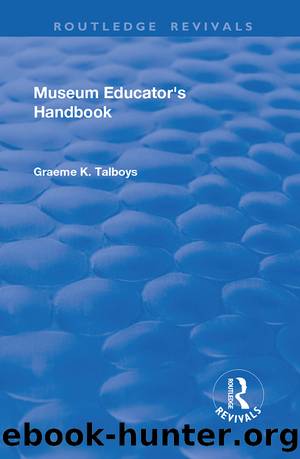Museum Educator's Handbook by Graeme K Talboys

Author:Graeme K Talboys [Talboys, Graeme K]
Language: eng
Format: epub
Tags: Language Arts & Disciplines, Library & Information Science, General
ISBN: 9780754644927
Google: 8DBDCD7FJ8MC
Publisher: Ashgate Publishing, Ltd.
Published: 2005-01-01T05:16:23+00:00
Why Groups Visit
As well as assessing the working environment of the museum, you will need to consider why educational user groups visit it. The primary answer (which is all too often overlooked or denigrated) is that they do so because specific demands of the curriculum or course they are following are best fulfilled by working in the museum. But there is a great deal more to museum work than simply the acquisition of knowledge (which is a tertiary function of education), as we have already discussed. There is the acquisition of educational skills - learning how to learn (a secondary function of education). There is the primary function, which is to equip students with the basic skills such as reading and writing needed to achieve the other functions. And there is the opportunity to introduce and explore wider social skills and issues.
In addition, there are a number of other reasons, perhaps subordinate to these, but perfectly valid in their own right. Among these are that museums allow students to break away from working with text-based information and to see that there is a wealth of material culture for study from many different temporal and geographical locations. Museums also present the opportunity to get away from the standard curriculum and explore the vast world beyond, enriching the understanding of what must be studied as well as showing that there is a great deal more.
Students come to museums to be shown the real thing. The psychological impact of proximity to or contact with genuine artefacts reaches deep and cannot be reproduced through the use of text. This impact is achieved through a better appreciation of an artefactâs scale, shape, texture, colour, even odour. But there is a less tangible quality to such items that is extremely potent, especially if they can be handled. This is their human connection - the fact that a student can handle and examine an artefact that was made and used by a real person hundreds, thousands or even hundreds of thousands of years ago. It is a connection that can be made intellectually without too much difficulty or too much impact, but once it is made emotionally, work with artefacts and collections takes on a whole new dimension.
Students can use museums to test hypotheses that they have formulated themselves or which they are studying. Despite the abundance of physical material to work with, many academic studies (be they made by young children or by university professors) rarely bother to check whether what they speculate upon is supported by the physical evidence. Quite often erroneous assumptions are promulgated and perpetuated when a little practical exercise would show them to be false. Controversial and disregarded statements might be given the irrefutable support they need by the same method.
As well as testing hypotheses, students will want to study artefacts in order to come to some sort of understanding about certain processes. The most common are those of manufacture, changes in style due to social pressures, wear and tear from use,
Download
This site does not store any files on its server. We only index and link to content provided by other sites. Please contact the content providers to delete copyright contents if any and email us, we'll remove relevant links or contents immediately.
Life 3.0: Being Human in the Age of Artificial Intelligence by Tegmark Max(5476)
The Sports Rules Book by Human Kinetics(4297)
The Age of Surveillance Capitalism by Shoshana Zuboff(4216)
ACT Math For Dummies by Zegarelli Mark(3996)
Unlabel: Selling You Without Selling Out by Marc Ecko(3591)
Blood, Sweat, and Pixels by Jason Schreier(3567)
Hidden Persuasion: 33 psychological influence techniques in advertising by Marc Andrews & Matthijs van Leeuwen & Rick van Baaren(3475)
The Pixar Touch by David A. Price(3369)
Bad Pharma by Ben Goldacre(3358)
Urban Outlaw by Magnus Walker(3342)
Project Animal Farm: An Accidental Journey into the Secret World of Farming and the Truth About Our Food by Sonia Faruqi(3178)
Kitchen confidential by Anthony Bourdain(3015)
Brotopia by Emily Chang(3002)
Slugfest by Reed Tucker(2944)
The Content Trap by Bharat Anand(2863)
The Airbnb Story by Leigh Gallagher(2800)
Coffee for One by KJ Fallon(2571)
Smuggler's Cove: Exotic Cocktails, Rum, and the Cult of Tiki by Martin Cate & Rebecca Cate(2474)
Beer is proof God loves us by Charles W. Bamforth(2376)
